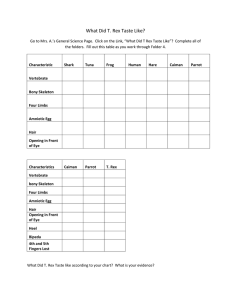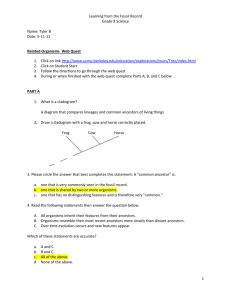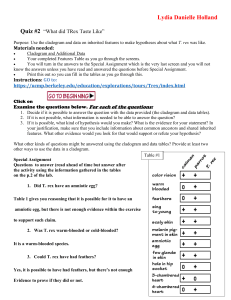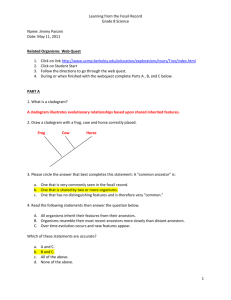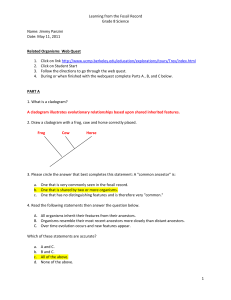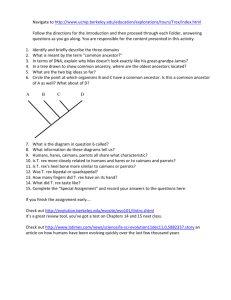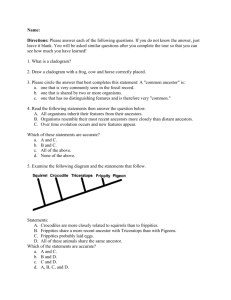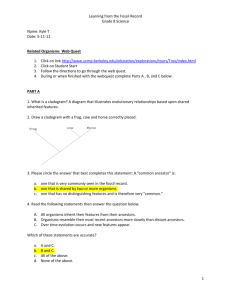T. rex Cladogram Activity: Evolutionary Relationships
advertisement
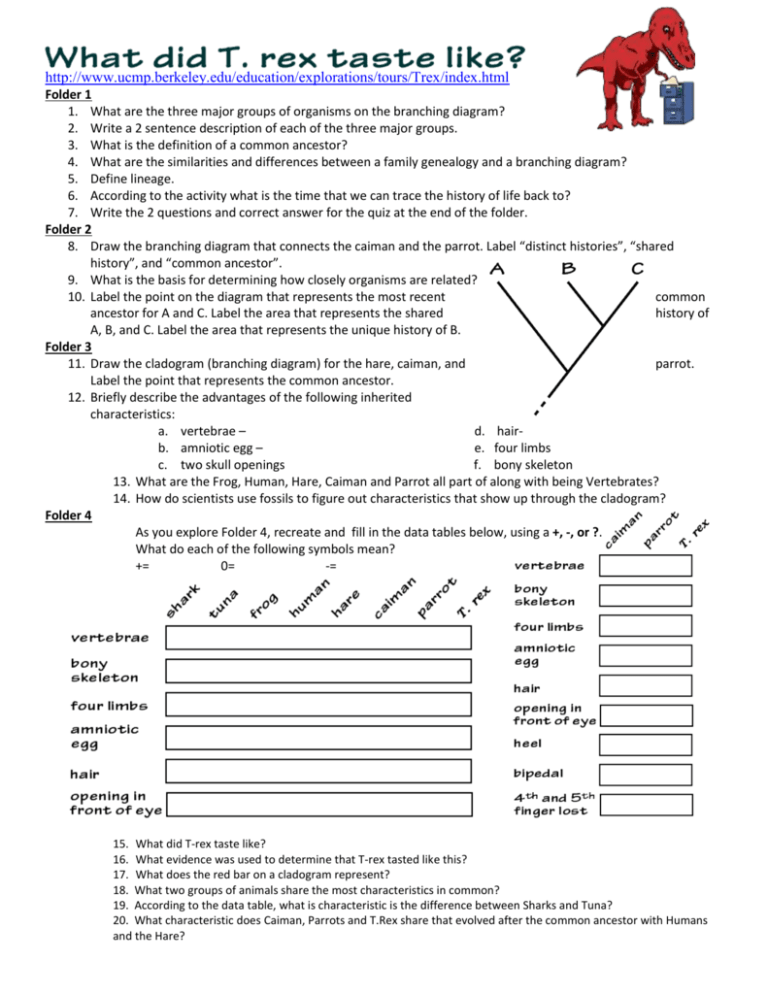
http://www.ucmp.berkeley.edu/education/explorations/tours/Trex/index.html Folder 1 1. What are the three major groups of organisms on the branching diagram? 2. Write a 2 sentence description of each of the three major groups. 3. What is the definition of a common ancestor? 4. What are the similarities and differences between a family genealogy and a branching diagram? 5. Define lineage. 6. According to the activity what is the time that we can trace the history of life back to? 7. Write the 2 questions and correct answer for the quiz at the end of the folder. Folder 2 8. Draw the branching diagram that connects the caiman and the parrot. Label “distinct histories”, “shared history”, and “common ancestor”. 9. What is the basis for determining how closely organisms are related? 10. Label the point on the diagram that represents the most recent common ancestor for A and C. Label the area that represents the shared history of A, B, and C. Label the area that represents the unique history of B. Folder 3 11. Draw the cladogram (branching diagram) for the hare, caiman, and parrot. Label the point that represents the common ancestor. 12. Briefly describe the advantages of the following inherited characteristics: a. vertebrae – d. hairb. amniotic egg – e. four limbs c. two skull openings f. bony skeleton 13. What are the Frog, Human, Hare, Caiman and Parrot all part of along with being Vertebrates? 14. How do scientists use fossils to figure out characteristics that show up through the cladogram? Folder 4 As you explore Folder 4, recreate and fill in the data tables below, using a +, -, or ?. What do each of the following symbols mean? += 0= -= 15. What did T-rex taste like? 16. What evidence was used to determine that T-rex tasted like this? 17. What does the red bar on a cladogram represent? 18. What two groups of animals share the most characteristics in common? 19. According to the data table, what is characteristic is the difference between Sharks and Tuna? 20. What characteristic does Caiman, Parrots and T.Rex share that evolved after the common ancestor with Humans and the Hare? Folder 5 complete the special assignment below: Cladogram Additional data Below is a simple cladogram indicating the proposed relationship among the caiman, parrot, and T. rex. This data table indicates the presence or absence of eleven additional features for the caiman and the parrot. Notice that the information about the T. rex has not been filled in. You will need to make that determination based upon what you have learned. Lineage might have been a new term for you. Which is the best definition for lineage? a) A single line showing age. b) A continuous line of descent. c) A set of parallel lines. Within this folder, you compared the history of a single family to the history of all life. What are some things that they have in common? a) Both have a point of common ancestry. b) In both, descendents inherit features from previous ancestors. c) In both, descendents more closely resemble their recent ancestors than more distant ancestors. d) All of the above. e) None of the above. Which feature do humans, hares, caimans, and parrots share that the other three lineages did not inherit? a) Bony skeleton b) Hair c) Amniotic egg What did T. rex taste like? a) Chicken b) Roast beef b) Tuna What evidence did we use to determine that T. rex tasted like chicken? a) T. rex's heel bone does not have a bump b) T. rex is bipedal c) T. rex has a reduced number of fingers d) a and b e) b and c Because T. rex was bipedal and had a reduced number of fingers, we can infer: a) that T. rex was more closely related to birds than to crocodiles b) that T. rex and birds inherited these features from a common ancestor c) that T. rex probably shares more features with birds than with other vertebrates d) all of the above e) none of the above
